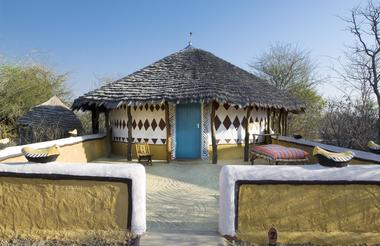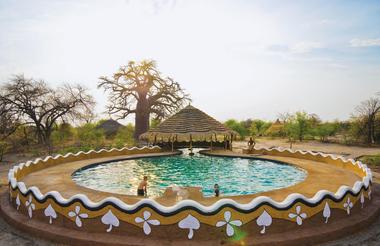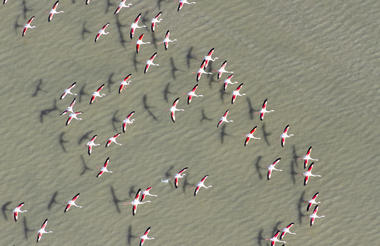On arrival at Maun Airport and once you have cleared passport control you will proceed to collect your bags and exit via customs to the arrivals hall. Here you will be met by an Africa Geographic representative and assisted to the awaiting transfer vehicle for your road transfer to Planet Baobab.
The transfer to Planet Baobab takes 2,5 hours
On arrival at Planet Baobab, you will be checked in and allowed to rest and relax, or enjoy lunch ( to your own account) at Planet Baobabs eclectic restaurant.
As the sun sets, you will meet up with your guide to enjoy a walk through the surrounding bush as he explains the local ecology, geology, and unique biology of baobabs. As the suns sets, you will find yourself a good spot to enjoy the skies turning ablaze with a cool drink over a campfire as your guide explains the fascinating geological origins of the Makgadikgadi - a vast saltpan desert, that is bigger than Switzerland, and was once the largest expanse of freshwater on the planet!
Soon after, you return to camp for dinner and your first night in a traditional Bakalanga Hut.



Solo Travellers please not that your activity costs have been based on sharing rates. Should there be no one else joining you on any of the scheduled and proposed activities mentioned in this itinerary, you will be requested by Planet Baobab staff to settle the balance required to confirm and run the activity with one person only.
Today you will wake up early, before the sun rises and head off into the vast grasslands, past lonely baobab sentinels, and to the edge of Ntwetwe saltpan. Along the way, your guide will explain the incredible adaptations of the species that are unique to the Kalahari desert environment. You enjoy a unique chance to explore the surroundings of Ntwetwe Pan in search of bat-eared foxes, ground squirrels and other unique desert species, plus learn about their struggle as they eke an existence against the elements in one of Africa's harshest wilderness.
As the morning warms up, a short stop allows you to jump off your vehicle, stretch your legs and enjoy your picnic breakfast.
At this most unsuspecting spot, you will get a chance to get up close and personal with a resident gang of habituated meerkats; and observe at close quarters how these incredibly social, superbly adapted animals interact with each other and their environment. You also get the chance to view the desert through the eyes of a meerkat – which, despite the fact that it’s only a foot off the ground, is a pretty spectacular vantage point, and definitely one of the most special and memorable game experiences you will encounter in Botswana.
Next, you’ll explore the vast nothingness of the Makgadikgadi, a place where vast expanses of sparkling saltpan extend as far as the eye can see.
Here, you can search for stone tools that remain scattered on the surface of the pan, whilst your guide gives a comprehensive explanation of the manufacturing of such tools and the evolution of man.
In the green season, you may be lucky enough to see the zebra and wildebeest of Africa’s second-largest migration (and the largest in the southern hemisphere!) as they congregate on the plains in search of fresh grass.
After you’ve finished this exploration, you will be returned to Planet Baobab, your home away from home in this extraordinary place…
Afternoon at leisure, and a night of peace and quiet amongst the baobabs.



Today you can choose between two options, which are additional extra that will complement your trip.
For those looking for a varied cultural experience, a visit to a nearby cattle post and village tour promises to be fascinating.
Essentially, after a delicious breakfast, you will drive to the nearby town of Gweta and take a tour of this "thriving" nanopolis to experience modern African village culture. Your guide will ensure you learn about the history and traditions of the Batswana, whose knowledge has been inherited from their forefathers. You will also visit the local primary school, ‘Sekolo’ with its outdoor classes under the morula tree, the Kgotla– a traditional court that governs the village and people of Gweta, and for the very brave, we recommend that you try out some freshly brewed sorghum beer!
Soon after you will set off to visit a local cattle post, where you will be shown around a traditional Batswana home.
Here you may get a glimpse of rural Botswana life and join your hosts for a traditional Kalanga meal of sorghum, with mealie meal, “seswaa” (beef stew), and delicious wild spinach, mopane worms (optional!!) and wild beans followed by a lip-smacking baobab fruit milkshake.
However, if you are here during the months when the Zebra Migration is about, you may want to spend a day out on a game viewer enjoying the massings. fresh green grass smells and spectacle of Botswana's Zebra migration.
In the Kalahari Desert rain is the ‘currency of life’ and it is incredible to see how, as soon as the rains arrive, the desert transforms into a green oasis teeming with life. Within days of the first rain, thousands of Burchell’s zebra and blue wildebeest make their way across the Makgadikgadi National Park to feed on the sweet summer grasses and enjoy the benefits of the mineral-rich saltpans.
Until recently, it was thought that the zebra and wildebeest came from the Boteti River, but recent research has shown that some of the zebras come from as far away as the Southern parts of the Okavango Delta. The route to the Makgadikgadi from the southern delta is no easy trot and this new data has emphasised just how incredibly important the Makgadikgadi area is to these animals.
While enjoying a picnic lunch in the shade of a grove of trees, feast your eyes on the awe-inspiring spectacle of the last surviving zebra and wildebeest migration in Southern Africa. This is the second-largest migration of African ungulates, with an estimated 30,000 animals, the majority being zebra, participating each year. Close behind the zebra and wildebeest follow hungry predators, and it is during the wet season that you might encounter lion, cheetah and, sometimes, even leopard or wild dog. Resident all year round is the rare brown hyaena, who does not hunt, but mainly scavenge and these fascinating and somewhat misunderstood animals benefit hugely from the arrival of the migration.
Also benefiting from this influx of life are the many birds of prey and vultures. The birdlife in the Makgadikgadi is every bit as fascinating as the wildlife and you are sure to spot some unique desert species, such as ostrich and sand grouse as well as the migratory waterbirds, which arrive with the rains. Waders, ibis, ducks, geese, storks, as well as the rare wattled crane, can be seen during this time, and towards the end of the season, flamingo can be seen resting on the pans before continuing on their migration.
Your guide will explain in great detail how mammals evolved; this process having been shaped by the complex but, fascinating relationship between predator and prey. The origins of hunting and water sourcing and its influence on man’s development will also be explained. Our guides are specialists and are able to convey all the nuances of the desert and the clever adaptations of its inhabitants that we consider one of the most interesting features of the environment.
The afternoon and late afternoon will be at leisure, with dinner and overnight back at Planet Baobab



Wake up to a perfect Kalahari sunrise and a good Planet Baobab breakfast followed by your return journey to Maun.
On arrival at Maun Airport you check-in for your onward flight, or meet up with your onward safari guide
The Africa Geographic team trusts you have enjoyed your experience, wish you a safe onward journey and hope to welcome you back in future to make more African inspired memories with us!
End of services








